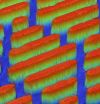NAMS issues first comprehensive recommendations on care of women at menopause and beyond
2014-09-17
(Press-News.org) CLEVELAND, Ohio (September 17, 2014)—The North American Menopause Society (NAMS) has published its key, evidence-based recommendations for the comprehensive care of midlife women—on everything from hot flashes to heart disease. The special feature, "The North American Menopause Society Recommendations for Clinical Care of Midlife Women," was published online today in the Society's journal Menopause. This is the first, comprehensive set of evidence-based recommendations for the care of midlife women freely available to all clinicians who care for women at this stage of life.
"Given the significant controversy and new research findings related to hormone therapy and other treatments for midlife women, this guide is greatly needed," says Dr. Jan Shifren, president of NAMS and a practicing gynecologist. "This succinct and evidence-based guide to clinical care will improve the understanding and management of women's health at this critical stage of life."
The key points and clinical recommendations, which are graded for their level of evidence, were carefully reviewed for accuracy and relevance, edited, and approved by an editorial panel of experts in midlife women's health from a wide range of specialties, including gynecologists, internists, medical and reproductive endocrinologists, cardiologists, neurologists, psychiatrists, psychologists, dermatologists, oncologists and counselors. The 2013-2014 NAMS Board of Trustees provided a final review and approval of the key points and recommendations.
"This very practical publication includes key points and recommendations for care on more than 50 important topics, including such key issues as vasomotor symptoms, osteoporosis and genitourinary syndrome of menopause," states Dr. Margery Gass, executive director of NAMS.
INFORMATION:
The North American Menopause Society (NAMS) started a revolution 25 years ago in the care of women at menopause and beyond, giving menopause care the focus it deserved in clinical practice and putting the standards of care for midlife and older women on solid scientific ground. To further the Society's mission, which is to promote the health and quality of life of all women during midlife and beyond, NAMS is making this valuable resource freely available to clinicians and women through the NAMS website, a trusted resource for both clinicians and patients. Go to http://www.menopause.org/clinrecs.
Founded in 1989, The North American Menopause Society (NAMS) is North America's leading nonprofit organization dedicated to promoting the health and quality of life of all women during midlife and beyond through an understanding of menopause and healthy aging. Its multidisciplinary membership of 2,000 leaders in the field—including clinical and basic science experts from medicine, nursing, sociology, psychology, nutrition, anthropology, epidemiology, pharmacy, and education—makes NAMS uniquely qualified to serve as the definitive resource for health professionals and the public for accurate, unbiased information about menopause and healthy aging. To learn more about NAMS, visit http://www.menopause.org.
ELSE PRESS RELEASES FROM THIS DATE:
Sharks' skin has teeth in the fight against hospital superbugs
2014-09-17
Transmission of bacterial infections, including MRSA and MSSA could be curbed by coating hospital surfaces with microscopic bumps that mimic the scaly surface of shark skin, according to research published in the open access journal Antimicrobial Resistance and Infection Control.
The study modelled how well different materials prevented the spread of human disease bacteria through touching, sneezes or spillages. The micropattern, named Sharklet™, is an arrangement of ridges formulated to resemble shark skin. The study showed that Sharklet harboured 94% less MRSA bacteria ...
Violent origins of disc galaxies probed by ALMA
2014-09-17
An international research group led by Junko Ueda, a Japan Society for the Promotion of Science postdoctoral fellow, has made surprising observations that most galaxy collisions in the nearby Universe — within 40 million light-years from Earth — result in so-called disc galaxies. Disc galaxies — including spiral galaxies like the Milky Way and lenticular galaxies — are defined by pancake-shaped regions of dust and gas, and are distinct from the category of elliptical galaxies.
It has, for some time, been widely accepted that merging disc galaxies would eventually form ...
Global shift away from cars saves US$100 trillion, eliminates 1,700 MT of CO2 pollution
2014-09-17
NEW YORK (17 September, 2014)—More than $100 trillion in cumulative public and private spending, and 1,700 megatons of annual carbon dioxide (CO2)—a 40 percent reduction of urban passenger transport emissions—could be eliminated by 2050 if the world expands public transportation, walking and cycling in cities, according to a new report released by the University of California, Davis, and the Institute for Transportation and Development Policy (ITDP).
Further, an estimated 1.4 million early deaths could be avoided annually by 2050 if governments require the strongest ...
'Smart material' chin strap harvests energy from chewing
2014-09-17
A chin strap that can harvest energy from jaw movements has been created by a group of researchers in Canada.
It is hoped that the device can generate electricity from eating, chewing and talking, and power a number of small-scale implantable or wearable electronic devices, such as hearing aids, cochlear implants, electronic hearing protectors and communication devices.
The first results of the device's performance have been published today, 17 September, in IOP Publishing's journal Smart Materials and Structures.
Jaw movements have proved to be one of the most promising ...
World Alzheimer Report 2014 reveals persuasive evidence for dementia risk reduction
2014-09-17
The World Alzheimer Report 2014 'Dementia and Risk Reduction: An analysis of protective and modifiable factors', released today, calls for dementia to be integrated into both global and national public health programmes alongside other major non communicable diseases (NCDs).
Alzheimer's Disease International (ADI) commissioned a team of researchers, led by Professor Martin Prince from King's College London, to produce the report. ADI is publishing this report, in conjunction with World Alzheimer's Day™ (21 September) and as a part of World Alzheimer's Month, an international ...
Diabetes complications make patients more likely to fall down stairs
2014-09-17
New research presented at this year's annual meeting of the European Association for the Study of Diabetes (EASD) in Vienna, Austria, shows that people suffering from diabetic peripheral neuropathy (DPN)—a complication of diabetes that affects the nerves in the limbs—are likely to sway more during stair climbing, and thus are more likely to fall. Steven Brown, Manchester Metropolitan University, UK, is the lead author on this research, which has been conducted by researchers at Manchester Metropolitan University and the University of Manchester, UK.
Patients with DPN ...
Study shows users of insulin pumps are at 29 percent lower risk of death compared with patients on insulin injections
2014-09-17
A study of more than 18,000 patients with type 1 diabetes has shown that use of insulin pumps to administer insulin rather than treatment with multiple daily insulin injections results in a 29% reduction in all-cause mortality and 43% reduction in the risk of fatal cardiovascular disease (CVD, i.e. coronary heart disease or stroke). The study is presented at the annual meeting of the European Association for the Study of Diabetes in Vienna, Austria, and was prepared by Dr Soffia Gudbjörnsdottir, University of Gothenburg, Sweden and colleagues.
Insulin pump treatment (CSII ...
The Lancet: Scientists use modern forensic techniques to identify most likely cause of King Richard III's death
2014-09-17
New research led by the University of Leicester in the UK gives a blow-by-blow account of the injuries inflicted on King Richard III's body at the Battle of Bosworth Field on Aug 22, 1485. Modern forensic analysis of the King's skeletal remains reveals that three of his injuries had the potential to cause death quickly—two to the skull (page 4, figure 4) and one to the pelvis (page 5, figure 6).
The remains of King Richard III—the last English monarch to die in battle—were found under a car park in Leicester by archaeologists from the University of Leicester, and subsequently ...
Urine HPV test could offer non-invasive alternative to conventional smear, improve screening uptake
2014-09-17
Human papillomavirus (HPV) is one of the most common sexually transmitted infections. Up to 80% of sexually active women are infected at some point in their lives and infection with specific "high risk" strains of HPV has an established link to cervical cancer.
Current screening by cervical cytology (smear test) is invasive and time-consuming - and in recent years, cervical screening in the UK has fallen below 80%, particularly amongst women aged 25-30. Several studies have suggested that detecting HPV in urine may be a feasible alternative to cervical sampling, but the ...
Hey1 and Hey2 ensure inner ear 'hair cells' are made at the right time, in the right place
2014-09-17
Two Johns Hopkins neuroscientists have discovered the "molecular brakes" that time the generation of important cells in the inner ear cochleas of mice. These "hair cells" translate sound waves into electrical signals that are carried to the brain and are interpreted as sounds. If the arrangement of the cells is disordered, hearing is impaired.
A summary of the research will be published in The Journal of Neuroscience on Sept. 16.
"The proteins Hey1 and Hey2 act as brakes to prevent hair cell generation until the time is right," says Angelika Doetzlhofer, Ph.D., an ...



